

The use of microencapsulated
biobullets in the control of invasive bivalves
DAVID ALDRIDGE
Department of Zoology, University of Cambridge
The widespread invasion of bivalve molluscs such as the zebra mussel,
Dreissena polymorpha, golden mussel, Umnopema fortunei,
and false mussels, Mytilopsis spp., has made them some of the
world's most economically and ecologically important pests. Despite
the development of numerous control methods, chlorination remains
the only widespread and licensed technique throughout the world. Mussels
are able to sense chlorine and other toxins in their surrounding environment
and respond by closing their valves, thus enabling them to avoid toxic
effects for up to three weeks. Furthermore, prolonged dosing of chlorine
in raw water produces ecotoxic trihalomethanes (THMs) by reaction
with organic material in the water.
We have developed a novel, environmentally safe and effective method
for controlling the biofouling mussels; the BioBullet. Our method
uses the encapsulation of an active ingredient (such as KCl) in microscopic
particles of edible material. The mussels' natural filtering ability
then removes and concentrates the particles from the water, without
stimulating the valve-closing response. By using the mussels' filtering
behaviour to concentrate BioBullets the absolute quantity of active
ingredient added to the water can be reduced substantially. Our approach
allows us to engineer the particles to break-up and dissolve completely
within a few hours, thus eliminating the risk of polluting the wider
ecosystem. We have demonstrated that the effectiveness of a toxin
in the control of biofouling filter-feeders can be enhanced greatly
by using our technique. Furthermore, successful industrial trials
indicate that the BioBullet provides a viable and more appealing control
option than those currently in use.
The British terrestrial
mollusc fauna – a bunch of successful invaders?
ROBERT CAMERON
University of Sheffield
Nearly all of our terrestrial mollusc fauna is "Invasive" in the sense that species colonised the post-glacial landscape and many did so very fast relative to their powers of active dispersal. Furthermore, many native species have shown striking changes in distribution and abundance (not always negative) in response to human-induced environmental change. Others seem slower to respond. I use various species, and comparison with faunas elsewhere, to ask questions about which features of dispersal, life history and habitat-tolerance characterise successful spreaders, and about what limits their progress.
Recruitment and growth
of Teredo bartschi (Teredinidae, Bivalvia) in hypersaline,
oligotrophic waters at Aqaba on the Red Sea.
S. M. CRAGG1, M-C. JUMEL1, F. AL-HORANI2 AND
I. W. HENDY1
1Institute of Marine Sciences, School of Biological Sciences,
Ferry Road, Portsmouth P04 9LY, UK
2Marine Science Station, P.O. Box 195, Aqaba 77110, Jordan
Cross-habitat differences
in crush resistance and growth pattern of zebra mussels (Dreissena
polymorpha): effects of calcium availability and predator pressure
MARCIN CZARNOLESKI
Institute of Environmental Sciences, Jagiellonian University cza...@eko.uj.edu.pl
We examined the growth pattern and shell strength of zebra mussels
Dreissena polymorpha in eight European locations characterised
by different survival rates, pH levels and calcium availability in
order to test: (1) whether trait variability can be attributed to
anti-predator responses, and (2) how their expression may depend on
the size of mussels and water chemistry.
Differences in chemical factors were unrelated to the cross-population
gradient in survivorship, suggesting mussels’ survival is affected
by other factors, such as predators. Increased population mortality
was associated with production of stronger shells by mussels 8, 10
and 12 mm long, and with slower growth of 12 and 14 mm long individuals.
Shell strengthening was unrelated to growth rate across populations.
Mortality correlated positively with Bertalanffy's growth coefficient
and negatively with asymptotic size.
Chemical parameters were unrelated to growth patterns; however, during
the experimental trials on crush resistance of 8 and 10 mm mussels
it appeared that they had interactive effects with mortality conditions.
Under low-mortality conditions, higher calcium concentrations and
lower pH stimulated production of stronger shells; the positive link
between shell strength and population mortality was detectable across
lower to medium calcium levels and medium to higher pH values.
The results suggest adaptive responses to predation through increasing
crush resistance and diversion of resources from growth to reproduction.
They also indicate that water chemistry can mediate induction of anti-predator
responses, and that their efficacy changes over the mussel’s
lifetime. We argue that a full consideration of the post-invasive
polymorphism of zebra mussels must incorporate the interplay between
environmental conditions and adaptive responses of mortality risk.
[POSTER]
Return to top
A review of the distribution
and ecological impacts of the zebra mussel (Dreissena polymorpha)
(Pallas) in Ireland
JON GRENNAN, TARA HIGGINS AND T.K. MCCARTHY
Department of Zoology, National University of Ireland, Galway
The introduction of zebra mussels (Dreissena polymorpha Pallas),
one of the most remarkable biological invasions in modern Ireland,
has involved significant ecological and economic impacts. Though native
to the areas surrounding the Black and Caspian seas, the species has
been dispersed widely in central and western Europe indicated an English
origin for the zebra mussel populations in Ireland. It is assumed
that high levels of polymorphism indicate a large founder population
and/or several introductions. First recorded in 1997, in Lough Derg
on the Shannon River, zebra mussels have subsequently been recorded
in most large physico-chemically suitable lakes in the Shannon system
and they also spread rapidly along linked navigation canal systems.
Zebra mussels are now spreading to smaller isolated lakes. A variety
of factors have been implicated in its range extension in Ireland,
including: high levels of inter-lake boat movement by anglers and
eel fishermen, favourable lake substrates and occasional deliberate
introductions.
Zebra mussels are extremely effective filter feeders and their presence
is associated with increased water transparency, elevated benthic
production, declines in native unionid populations and they are also
thought to be a threat to rare fish species such as pollan (Corgonus
autumnalis) and arctic char (Salvelinus alpinus). Existing
literature on the introduction and dispersal of the zebra mussel in
Ireland is reviewed and the attempts to limit further range expansion
discussed. Research now in progress as part of a large scale biodiversity
research programme (Biochange), aims to provide a better understanding
of the ecological effects of zebra mussel in a selection of small
western Irish alkaline lake ecosystems.
Return to top
Using Geographical Information
Systems to predict the spread of an invasive species, the manila clam
Ruditapes philippinarum (Adams and Reeve, 1850)
MATT HARRIS
University of Portsmouth
Ruditapes philippinarum is a filter feeding bivalve mollusc.
Its natural distribution is in the western Pacific. It has been introduced
into western Europe, in particular northern France, Italy and the
United Kingdom. It has become established in Poole Harbour.
This project aims to utilise Geographical Information Systems to predict
the potential spread of this species. This will be initiated by mapping
areas of favourable environmental conditions such as substrate composition
onto a map of Langstone Harbour. Once the predictions have been made,
these areas will be seeded with adult clams to investigate the actual
suitability of the site. An associated study will also be commissioned
to determine the effects of environmental conditions on the more sensitive
embryological larval stages of R. philippinarum. [POSTER]
Return to top
Impacts of zebra
mussel infestation on water quality and algal populations in western
Irish lakes
TARA HIGGINS
Department of Zoology, National University of Ireland, Galway
Since it was first recorded in Lough Derg in 1997, the invasive
zebra mussel Dreissena polymorpha has rapidly spread to lakes
across Ireland. Dreissena are effective filter feeders with
extremely high clearance rates of microalgae, cyanobacteria and other
particles. Their infestation has induced profound ecological changes
in lakes worldwide, affecting nutrient cycling, levels of suspended
solids and phytoplankton populations, with associated food-web mediated
effects on native zooplankton and fish populations. Focusing on a
selection of lakes in Western Ireland, the current research examines
the effects of the selective filter-feeding Dreissena on water
quality and nutrient status, with particular emphasis on algal abundance
and community composition.
Detailed comparison is made between two adjacent mesotrophic-eutrophic
lake basins, Loughs Doon Upper and Lower, only the latter of which
is infested with zebra mussels. Our results support international
research associating zebra mussel infestation with increased water
clarity, greater periphyton relative to phytoplankton production,
an elevated risk of cyanobacterial blooms but a 30%-40% overall reduction
in water column chlorophyll-a. Such trends present difficulties to
categorising infested lakes according to traditional (OECD) and developing
(EU Water Framework Directive) trophic classification schemes. The
study aims to establish an effective framework within which the ecological
effects of zebra mussel infestation in Irish lakes can be predicted.
Synanthropic terrestrial
mollusk faunas of Colorado and Utah
JOHN M. C. HUTCHINSON1 & HEIKE REISE2
1Max-Planck-Institut für Bildungsforschung, Berlin;
maj...@googlemail.com
2Staatliches Museum for Naturkunde Gorlitz; Heik...@smng.smwk.sachsen.de
Our aim was to establish semi-quantitatively the most important
synanthropic species in big conurbations such as Denver and Salt Lake
City positioned on either side of the Rocky Mountains. The conurbations
on both sides of the mountain have similar continental climates, and
are both only 150 years old.
The synanthropic sites surveyed were mostly garden centres, flower
beds and bushes around town centres, public gardens, parks and cemeteries.
We sampled 31 sites in Colorado, from Fort Collins to Colorado Springs,
and 28 sites in Utah, from Logan to Provo. At most cultivated sites
the generous and regular watering, usually by automatic systems, sustained
a molluscan fauna, and some gardeners even felt the need to apply
molluscicides. Wood-chip mulch was extensively used to conserve moisture,
which made it particularly favourable for Vallonia species.
However, some intensively tended, but sparsely watered, allotments
were devoid of molluscs and most uncultivated rough ground also dried
out too much.
Results showed that European and Holarctic molluscan species predominated.
The introduced Deroceras reticulatum, Oxychilus draparnaudi
and Arion fasciatus were particularly widespread,
extending also into some less disturbed sites along rivers and up
in the mountains. Several other introduced pest species (e.g. Deroceras
panormitanum) were more widespread than published records suggest.
Species such as Arion circumscriptus, which are mostly not
distinguished in the North American literature, were identified by
dissection (where necessary after rearing specimens to adulthood).
The garden centres were especially rich in mollusks; supplies of material(s)
from out of state were very regular, and provide a ready means for
the spread of exotics despite the difficulty of unassisted dispersal
in the dry climate. This could explain the similarities in molluscan
faunas within and between states, but there are exceptions: e.g.
Oxychilus alliarius and Arion intermedius were not uncommon
in Utah, but not found in Colorado, whereas Oxychilus cellarius
appeared only at two sites in Colorado; similarly within Colorado
A. circumscriptus was restricted to localities around Boulder.
Return to top
Mitigation of the Japanese
oyster Crassostrea gigas by heat treatment
HENK JENNER
KEMA, PO Box 9035 Arnhem, Gelderland 6800 ET, The Netherlands
Crassostrea gigas populations have developed on the Dutch
coast at a rather high speed. They often settle in cooling water conduits
and growth is high leading to massive fouling especially in low water
velocity parts of the system. The common heat treatment for killing
of the mussels and barnacles has been shown to be insufficient against
the oysters. C. gigas is not untowardly affected by the traditional
40oC exposure associated with heat treatment.
In a series of experiments at the Eems power plant we found that an
exposure to 45oC for 1 h was needed together with a rather
slow build up (over 2h) to 45oC to ensure 100% mortality.
Such heat treatment could affect any coatings used and could compromise
auxiliary cooling circuits depending on detailed plant design. They
also revealed the need to repeat the treatment sufficiently frequently
to ensure any C. gigas killed would not detach at sizes that
would cause problems on narrow-bore systems downstream within the
plant. Should such higher temperature regimes be proposed in practice
there would inevitably be issues with the regulator over the thermal
discharge involved.
Return to top
Attachment strength,
aggregation and movement of the zebra mussel (Dreissena polymorpha)
in the presence of potential predators
JAROSLAW KOBAK1 AND TOMASZ KAKAREKO2
1Department of Invertebrate Zoology, Institute of General
and Molecular Biology, Nicolaus Copemlcus University, Gagarina 9,
87-100 Toruli, Poland, jko...@biol.uni.torun.pl
2Department of Hydrobiology, Institute of Ecology and Environmental
Protection, Nicolaus Copemicus University, Gagarina 9, 87-100 Toruli,
Poland, kak...@biol.uni.torun.pl
We studied the behaviour of the zebra mussel, Dreissena polymorpha,
in the presence of four predator species with different feeding habits:
(1) roach Rutilus rutilus, a specialized molluscivore, (2)
racer goby Neogobius gymnotrachelus and (3) crayfish Orconectes
Iimosus, both opportunistic molluscivores, and (4) perch Perca
fluviatilis, which does not feed on molluscs. The mussels were
separated into small (<10 mm), medium (10-17 mm) and large (>
17 mm), and their behaviour was monitored in 100L tanks. The mussels
were protected by a 1 mm mesh when in presence of predators, but not
when in a control tank.
Small and medium sized mussels were affected only by the presence
of roach, the most efficient molluscivore used. Their behaviour was
not influenced by the presence of the other species. Large mussels
did not respond to the presence of any of the predator species. Large
mussels may exceed a threshold size for particular predatory species,
and their anti-predator behaviour may be weaker.
The strength of attachment of mussels onto a PVC substrate was measured
with a digital dynamometer. Small and medium sized mussels, exposed
for six days, attached more strongly in the presence of roach than
in other treatments. Furthermore, the percentage of mussels forming
aggregations (i.e. touching each other) was higher in the presence
of roach than in the control treatment.
To measure horizontal distance moved by mussels, we put a single individual
into a circular dish with a 2-3 mm layer of sand. A moving mussel
left a trail in the sand, which was photographed and measured. Mussels
did not alter the intensity of their movements following exposure
to any of the predator species tested.
Small mussels tend to move upwards on a vertical surface. To check
if this behaviour would change in the presence of predators, we put
a single individual into a test-tube and measured the vertical distance
it moved in 24 h while exposed to predators. Our results showed that
small mussels reduced their vertical movement significantly in the
presence of Rutilus rutilus.
Return to top
The occurrence of
Potamopyrgus antipodarum (Gray, 1843) (Prosobranchia: Hydrobiidae)
in the mining subsidence reservoirs affected by coal mine output (Upper
Silesia, southern Polland)
IGA LEWIN
The University of Silesia, Faculty of Biology & Environmental
Protection, Department of Hydrobiology, 9 Bankowa Str., 40-007 Katowice,
Poland
Potamopyrgus antipodarum (Gray, 1843), the New Zealand mud
snail, was first recorded in Poland in 1933, and its rapid expansion
has been observed in Upper Silesia, southern Poland, from the 1990s.
The study was carried out in the years 1997-2007 in Upper Silesia,
south Poland, and investigated the occurrence of P. antipodarum
in the mollusc communities in seven mining subsidence reservoirs
affected by coal mine output in relation to environmental factors.
It was shown that since 1997, P. antipodarum has been eudominant
in the mollusc communities in the mining subsidence reservoirs, and
was found in the submerged parts of Glyceria maxima grass
and on the concrete lining of water banks.
PCA was employed to analyse ecological and physicochemical data from
the different sampling sites. Any significant differences in the shell
height of P. antipodarum collected from the different sampling
sites were tested by means of the Kruskal-Wallis method. PCA analysis
showed a positive correlation between mollusc density and pH, the
concentration of chlorides, the total hardness, alkalinity and total
dissolved solids, and a negative correlation between the number of
species and phosphates.
The survey confirmed that there has been an invasion by P. antipodarum
into the reservoirs and rivers of Upper Silesia.
Return to top
The decline and extirpation
of unionids in large Irish lake invaded by zebra mussels: invasion
history as a predictor of impact
CAITRIONA M. MAGUIRE1, ROBERT ROSELL2 AND
DAI ROBERTS3
1Aquatic Systems Group, Queens University Belfast, Newforge
Lane, Belfast. BT9 5PX.
2Aquatic Systems and Fisheries Group. Agri-food and Biosciences
Institute, Newforge Lane, Belfast, BT9 5PX
3School of Biological Sciences, Queens University Belfast,
Medical Biology Centre, 97 Lisburn Road, Belfast
Invasion history of a species is considered to be one of the best
predictors of impact at present. The impacts of the zebra mussel Dreissena
polymorpha in Europe and North America are similar with the
exception of impact on native unionids. In North America some unionid
populations have been extirpated, whereas in Europe, there are no
documented cases and unionids can maintain high densities in the presence
of Dreissena. We hypothesise that the impact in Ireland would
be similar to North America, as Ireland, unlike continental Europe
has no evolutionary experience of Dreissena and has low unionid
diversity.
Return to top
Monacha cartusiana
(Müller, 1974): the phylogenetic study of the central Europe
populations has started
MÍKOVCOVÁ ALENA1, JURICKOVÁ LUCIE2
AND PETRUSEK ADAM1
Charles University in Prague, Faculty of Science, Departments of Ecology1
and Zoology2, Prague, CZ. alen...@centrum.cz
The main aim of the study was to explain factors affecting the distribution
of the presumably non-indigenous land snail Monacha cartusiana
(Muller, 1774). Currently, M. cartusiana is spreading from
its original range in the Mediterranean to western and central Europe.
The number of recorded populations of this species in the Czech Republic
has increased significantly especially in the last 15 years. This
data makes M. cartusiana a good model for evaluating factors
that may facilitate invasions of terrestrial molluscs.
The proposed project has two parts. Firstly, Czech populations with
different life histories (e.g. well-established over wintering populations
vs. short-term invasions) will be compared with populations from the
Mediterranean, and the survival ability of individuals from Southern
Europe under Central European climatic conditions is tested. Secondly,
intraspecific diversity and hypotheses of origin of newly established
populations will be tested by means of phylogenetic and phylogeographic
analysis of M. cartusiana populations in comparison with populations
of other related species.
We would like to establish a partnership with malacologists throughout
Europe to obtain new experiences, contacts and materials for the phylogenetic
and phylogeographic studies: for further information please contact
Alena. [POSTER]
Return to top
Shell asymmetry in mussels
R. NAGARAJAN1,2, STEPHEN E. G. LEA2, AND
JOHN D. GOSS-CUSTARD3
1Department of Zoology and Wildlife Biology, A.V.C. College
(Autonomous) Mannampandal-609305, India
2School of Psychology, Washington Singer Laboratories.
Perry Road, University of Exeter, Exeter EX4 4QG, UK
The common edible blue mussel (Mytilus edulis) appears to
be symmetric in morphology. However, we found that the predators that
prey on mussels consistently attack one side of the valve. Morphometric
measurements on symmetrical variables viz., shell depth, weight, dorsal
and ventral thickness of the right and left valves were made on mussels
collected in the Exe estuary of south west England. Almost all mussel
shells (between 95% and 99%) were asymmetrical. Right valves were
consistently thinner than left: the mean difference (right minus left)
was -0.008 to 0.003mm and -0.014 to 0.09mm for ventral and dorsal
thickness respectively and -0.012 to 0.086g for shell weight. All
differences were significantly different from zero. The mean depth
difference between left and right valves was 0.003 to 0.049mm, but
this was only marginally significant.
Furthermore, the right valve is thinner ventrally and dorsally in
a significantly higher proportion of mussel shells, whereas the left
one was frequently found to be deeper. The asymmetry in ventral and
dorsal shell thickness, shell weight and shell depth does not change
significantly (Chi-square tests applied) across the length classes
of mussels.
Finally, trends of shell asymmetry in different bivalve species from
various localities are discussed.
Return to top
Alien non-marine
mollusks in Poland
BEATA M. POKRYSZKO
Museum of Natural History, Wroclaw University, Sienkiewicza 21, 50-335
Wroclaw, Poland
bep...@biol.uni.wroc.pl
The terrestrial and freshwater malacofauna of Poland includes 265
species: 177 terrestrial gastropods, 56 freshwater snails and 32 bivalves.
Twenty seven (17 terrestrial, 10 aquatic) are regarded as alien components
of the fauna, found in natural habitats (Lithoglyphus naticoides),
both anthropogenic and natural-seminatural habitats (Dreissena
polymorpha, Potamopyrgus antipodarum, Physella acuta,
Ferrissia clessiniana, Arion distinctus, A. fasciatus, Deroceras turcicum,
Boettgerilla pallens, Helicella itala, H. obvia), anthropogenic
habitats (Arion lusitanicus, Oxychilus draparnaudi, Monacha cartusiana)
and synanthropic habitats (Anodonta woodiana, Corbicula fluminalis,
C. fluminea, Melanoides tuberculatus, Menetus dilatatus, Oxychilus
translucidus, Zonltoides arboreus, Tandonia budapestensis, Limax maximus,
L. flavus, Lehmannia valentiana, Deroceras panormitanum, Opeas pumilum).
Considering the relatively short period available for colonisation
since the Ice Ages, the native fauna is still unsaturated and - given
time - some of the species regarded as alien would have spread in
Poland anyway. From this viewpoint the immigrants can be classified
into 'potentially native' - species whose expansion was only accelerated
as a result of human activities while the adequate habitats had always
been there (Dreissena polymorpha, Potamopygrus antipodarum, Lithoglyphus
naticoides, Arion distinctus, A. fasciatus, Deroceras turcicum, Boettgerilla
pallens) and ‘truly alien’ - species whose expansion
was rendered possible due to man-made habitats (Anodonta woodiana,
Corbicula fluminalis, C. fluminea, Melanoides tuberculatus, Menelus
dilatatus, Physella acuta, Ferrissia clessiniana, Arion lusitanicus,
Oxychilus draparnaudi, O. translucidus, Zonitoides arboreus, Tandonia
budapestensis, Limax maximus, L. flavus, Lehmannia valentiana, Deroceras
panormitanum, Opeas pumilum, Helicella itala, H. obvia, Monacha cartusiana).
In the latter group, some species have recently started to penetrate
from anthropogenic into natural habitats (Physella acuta, Ferrissia
clessiniana, Arion lusitanicus, Helicella itala, H. obvia) while
the remaining ones are limited to habitats under continual human impact.
The geographical origin of the immigrants is: elsewhere in Europe
(17 species), Asia (4), Nearctic (3), the Caucasus (2) and New Zealand
(1). Eight species are early immigrants (19th c. at the latest), and
19 are recent (20th c.) or very recent arrivals. Six have expanded
to the entire country whereas three are expanding. 14 are likely to
do so, three show no sign of expansion and one - after initial rapid
expansion - is now endangered. Sixteen of our alien species are non-pests;
two of these (Arion distinctus, Oxychilus draparnaudi) become
pests in certain situations, six (Dreissena polymorpha. Arion lusitanicus,
Zonitoides arboreus, Limax flavus, L. maximus, Lehmannia valentiana)
are regarded as pests, and two are suspected of a negative effect
on the native fauna (Potamopygrus antipodarum) or parasite
transmission (Melanoides tuberculatus); in one case (Deroceras
panormitanum) it is too early to judge the consequences of expansion.
Return to top
Non-native molluscan
fauna present in the Minho estuary, Portugal
RONALDO SOUSA1,2, CARLOS ANTUNES3, LÚCIA
GUILHERMINO2
1CIIMAR - Centro Interdisciplinar de Investigação
Marinha e Ambiental. Rua dos Bragas 289. 40S0-123 Porto, Portugal
(e-mail: rona...@ciimar.up.pt)
2ICBAS - Instituto de Ciancias Biomédicas de Abel
Salazar, Departamento de Estudos de Populações, laboratório
de Ecotoxicologia, Universidade do Porto, Lg. Prof. Abel Salazar 2,4099-003
Porto, Portugal
3Aquamuseu do Rio Minho - Parque do Castelinho, 4920-290
Vila Nova de Cerveira, Portugal
Genetic variability in
the alien razor clam Ensis directus: preliminary data from
CO1 gene
JOAQUIN VIERNA, ANDRES MARTINEZ-LAGE AND ANA GONZÁLEZ-TIZÓN
Department of Cell and Molecular Biology. University of La Coruña.
A Zapateira s/n. E-15071. La Coruña. SPAIN. www.udc.es/dep/bm/genetica/a/indice.htm
The American razor clam Ensis directus was introduced in
Europe in the late 1970s, probably in ballast water. By larval and
post-larval drifting this species rapidly spread along European coasts.
Since 1978, it has been recorded in Scandinavia, Denmark, Belgium,
The Netherlands, France and Great Britain. This bivalve inhabits marine
and brackish waters (1-20 m deep), buried in sandy bottoms in inter-
and subtidal areas.
Different studies of invasive mollusc populations have shown higher
than expected levels of genetic diversity. These studies have used,
preferentially, mitochondrial DNA and/or microsatellite markers.
In the present work we amplified and sequenced a partial region of
the mitochondrial cytochrome oxidase subunit I gene (COI) in individuals
of E. directus from three Danish localities. Restriction
fragment length polymorphism (RFLPs) were performed using Hae III,
Taq I and Msp I endonucleases. Results show higher variability than
that previously obtained using 16S rRNA. [POSTER]
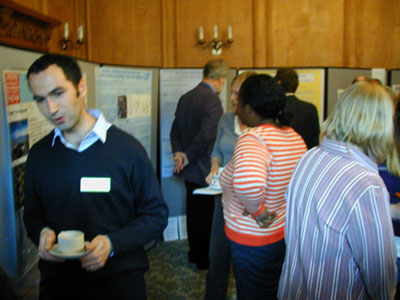 |
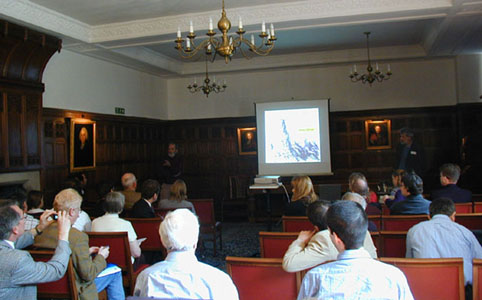 |
|
| The Invasive Molluscs meeting at Cambridge
University.
Top left: Meeting organiser, David Aldridge at the Poster Session. Top Right: Meeting in progress. Middle: Reception in the Zoology Museum—from a giant sloth’s viewpoint. Bottom left: Richard Preece introduces participants to the Museum. Bottom right: John Hutchinson in reflective/bullish mood. |
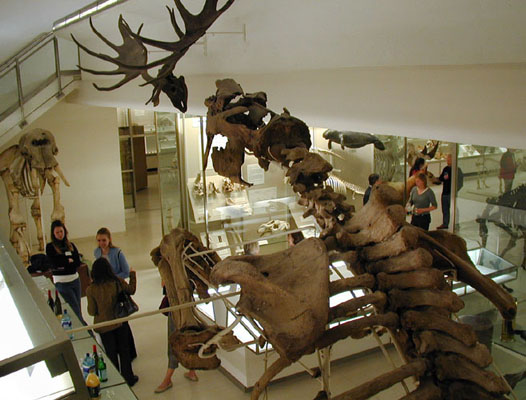 |
|
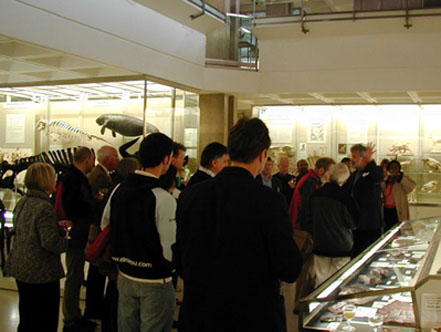 |
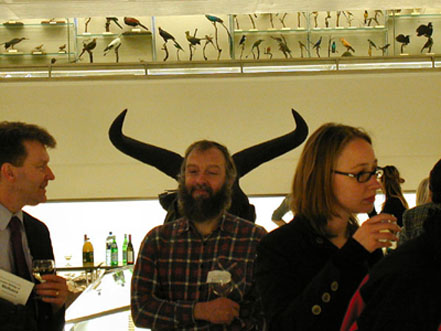 |
|